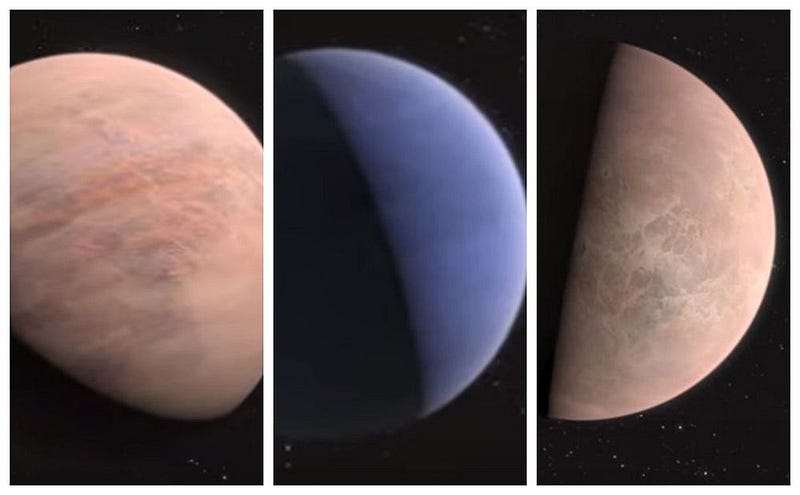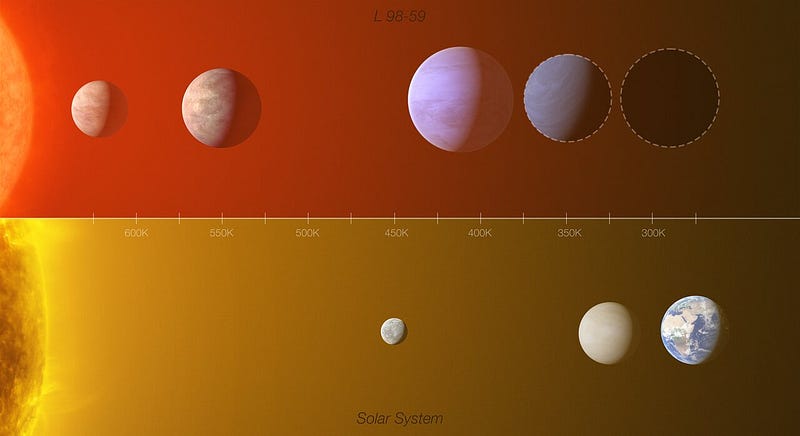Wealth of Exoplanets in the L 98–59 Star System
Written on
Chapter 1: Exploring the L 98–59 Star System
The L 98–59 star system features a fascinating array of exoplanets, including one that is merely half the mass of Venus, a potential water-rich world, and possibly another planet located within the habitable zone of this stellar system.

Artist depictions of the L 98–59 worlds are based on the latest data from the European Southern Observatory. Image credit: Stills recorded from ESO videos / Collage by The Cosmic Companion
Utilizing the European Southern Observatory’s Very Large Telescope (VLT) in Chile, astronomers have investigated three captivating worlds within the L 98–59 star system, located a mere 35 light-years away from Earth. These planets were initially detected in 2019 via NASA’s Transiting Exoplanet Survey Satellite (TESS), which identifies exoplanets that transit in front of their stars—a method known as the transit technique.
Follow-up observations employed the Echelle SPectrograph for Rocky Exoplanets and Stable Spectroscopic Observations (ESPRESSO) on the VLT. This advanced tool has enabled researchers to scrutinize the L 98–59 exoplanets with remarkable precision.
Section 1.1: Potential for Water
Research suggests that all three identified planets may possess water, although it is likely scarce on the two innermost worlds. The outermost planet is particularly intriguing, as it might be a water world, potentially composed of up to 30% water by mass.

An infographic depicting the L 98–59 planetary system in comparison to our own. Image credit: ESO/L. Calçada/M. Kornmesser (Acknowledgment: O. Demangeon)
“L 98–59 is a bright M-dwarf star located 10.6 parsecs away. Situated at the edge of the continuous viewing zone of the James Webb Space Telescope, this system is poised to become a key focus for comparative studies of terrestrial exoplanets,” the researchers note in the journal Astronomy & Astrophysics. The exoplanet that is half the mass of Venus is the lightest discovered so far using the radial velocity method, which detects the gravitational influence of a planet on its host star.
This video explores the significance of the L 98-59 star system and its unique planetary features.
Section 1.2: The Search for Life
Astronomers are optimistic about their ability to analyze the atmospheres of exoplanets orbiting distant stars in the near future. By examining the light that passes through a planet’s atmosphere as it travels from its star, researchers can identify the chemical makeup of these alien environments. Certain markers could indicate the presence of life, even primitive forms that might not have developed advanced technology.
However, current telescopes are not yet advanced enough to conduct the in-depth investigations needed for these next-generation studies of smaller, rocky planets. “The planet located in the habitable zone may have an atmosphere capable of supporting and protecting life,” explains María Rosa Zapatero Osorio, an astronomer at the Centre for Astrobiology in Madrid, Spain.
The team also identified a fourth exoplanet in orbit around L 98–59, along with indications of a potential fifth planet within this system.
Chapter 2: Join the Cosmic Community
James Maynard, the founder and publisher of The Cosmic Companion, is a native of New England who has embraced life in Tucson alongside his wife, Nicole, and their cat, Max.
Did you find this article informative? Join us at The Cosmic Companion Network for our podcast, weekly video series, engaging newsletter, and news briefings on Amazon Alexa, among other offerings!
This video presents an overview of the exoplanets within the L 98-59 system, showcasing their unique characteristics and potential for habitability.
This video features an artist's impression of L 98-59b, providing a visual representation of this intriguing exoplanet.